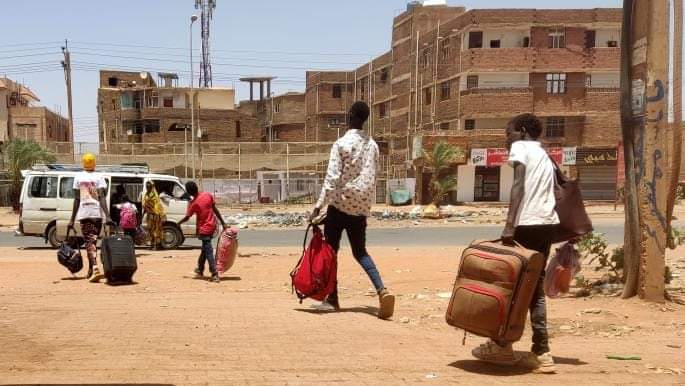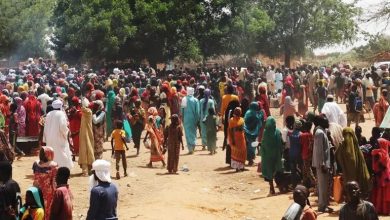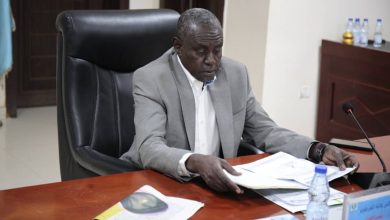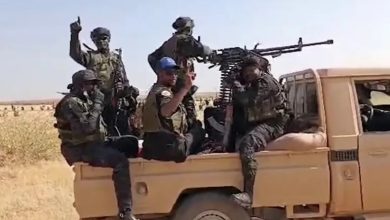The Courage of Despair

In the paths of survival heading north, the invasion of Al-Jazirah state by the Rapid Support Forces (RSF) and Wakasiba has brought calamity upon Sudanese citizens, forcing many displaced people from Khartoum to flee once again, joined by new refugees. Some chose to give themselves and their possessions a chance to adapt to post-2023 Sudan, negotiating with the RSF in areas around Rufaa and Hilaliya. However, many opted to escape to safety. Some headed south toward the Blue Nile and Sennar states, while others went east to the Red Sea, Gedaref, and Kassala states. Others chose to return to Khartoum, while some despaired of their homeland and were forced to leave through paths carved by pain, helplessness, and perhaps death.
From Abu Haraz to Egypt
In a town where the ears were accustomed to the regular beats of traditional drums and the amplified voices of religious chants from the mosques, Abu Haraz woke up to loud, unfamiliar noises recognizable only to some survivors of the Khartoum war and participants of the December revolution. The question on everyone’s mind in Abu Haraz on the 15th of December last year was about the nature of the sound that disturbed the city’s peace on that quiet Friday. The answer came from the gunfire itself, which pierced the tall neem trees and defied any laws of humanity.
Once the people grasped the situation, realizing it was the war knocking on Al-Jazirah state’s door, warnings were exchanged loudly, overshadowed by cries of fear: “Lie down on the ground under the beds, it’s bullets,” Amal told “Atar.”
“I understood from the first shot that it was my duty to calm my family, as I had grown accustomed to the sounds of gunfire from both the army and RSF since the December 2018 protests and later during the Khartoum war when the generals clashed. I did this by crawling to the kitchen to make tea, coffee, and breakfast, fearing for my mother, who has high blood pressure, and my father, who has diabetes.”
According to Amal, the first clash lasted about three hours, followed by a period of relative calm and sporadic gunfire. “After that, there was only one thought dominating everyone: where will we go? And how?”
After nine months of war, everyone was waiting for the decisive moment in Khartoum, with a hesitant belief that the battle would not reach Al-Jazirah state, especially since direct clashes had decreased in the capital. However, with no signs of the army in Abu Haraz and the RSF’s advance into the area’s narrow alleys, their leaders ordered families living near the Medani-Khartoum eastern road to evacuate their homes, which were then completely occupied.
“My family and I were among those families. That’s when our psychological and physical displacement began—the former for my family and the latter for me after being displaced from Khartoum to Al-Jazirah.”
Stations of Survival
Speaking to “Atar,” Amal said they crossed several difficult points on their survival journey. “We reached some by sheer perseverance.” The first was the village of Al-Naji, about 20 kilometers from Abu Haraz, where a significant number of families gathered. All discussions revolved around the challenges and high cost of securing a visa to Saudi Arabia and the exorbitant prices of Egyptian visas after waiting for months.
“We chose, for budgetary reasons and due to the lack of identification papers for some family members, Egypt as our destination, but through smuggling, which had become a frequent topic of conversation among Sudanese in the country, as well as a source of concern, especially with the presence of children and elderly people in poor health among most families who had gathered in Al-Naji.”
Those who survived the war and took the smuggling route to Egypt became essential guides for others seeking refuge. “We left Al-Naji in a large transport truck, ‘Dafar Jumbo,’ taking the unpaved, relatively long Om Al-Qura-Faw road to Gedaref, passing through an RSF checkpoint in the village of Arbaeen in Om Al-Qura locality. One of the passengers on the truck pointed out that they were under the command of Keikel. The RSF soldiers’ questions were brief as they glanced quickly into the truck before letting us proceed. Our next stop was Atbara, which we reached after nearly 24 hours due to the curfew imposed on movement between cities and states. We arrived at Atbara’s main bus station, which was crowded with bags and families fleeing the horrors of the war in Al-Jazirah. They were all implicitly agreeing on the same destination: Cairo, via smuggling.”
At the Atbara bus station, vehicles lined up openly calling for passengers to Egypt. Those wanting to cross the border illegally could choose between small transport cars (pickups), passenger vehicles (trucks), or private cars, and there was a small sign above one of the offices that read, “Atbara – Aswan.”
Amal said her family, along with another, made an agreement with a “Box” transport truck driver who had been recommended for his knowledge of the road to Cairo. “In Abu Hamed, we met the driver Mahmoud, who sent a voice recording discussing the storage of the cargo (us) in a hotel in Abu Hamed for two days before the cargo would move towards Al-Abyar on the Sudanese border, where another driver, coming from Egypt, would take over. We reached Al-Abyar on the evening of the third day, where we spent a harsh night due to the cold, the heavy presence of flies, and human waste. There, we met the driver Ibrahim, who had come from Egypt with nearly forty barrels of fuel in a rundown ‘Box’ transport vehicle with a single cabin. Drivers prefer not to use new vehicles within Egypt’s borders for fear of confiscation, despite the high fees they charge passengers, which amount to 350,000 Sudanese pounds per person from Abu Hamed to the outskirts of Aswan. At the border, the cargo was exchanged between the drivers: 20 barrels of fuel for another load consisting of ten people and their sorrow.”
Inside Egypt
From Atbara, there are two routes for survivors to choose from, both old smuggling routes known to traffickers between the two countries. One leads to Abu Hamed and then to the border, while the second heads to Sidon and then to the border. Often, the first driver within the Sudanese border arranges with the one receiving passengers at the border, but in many cases, it is left to chance and negotiation. The first driver knows that the vehicle smuggling fuel from Egypt is looking to make extra money by smuggling people. In this, many fall victim to the drivers’ bidding wars and greed. According to some who have taken these routes, the Sidon road is only used by drivers from the Rashaida tribe, while the Zubaidiyah take the Abu Hamed route. “Drivers talk about what seems to be an implicit agreement between those in the smuggling business or those who own the vehicles used for smuggling,” one survivor told “Atar.”
Abu Hamed – Al-Abyar – Aswan
Another stage of the journey, different in nature, begins upon entering Egypt’s borders. This phase is characterized by reckless driving speeds, dangerous terrain, dense dust, and bitter cold.
“The driver warned us before departure, saying there would be no stops, as the authorities might confiscate the vehicles if we encountered them, especially in the area between Al-Abyar and the quarries at the entrance to Aswan. That didn’t prevent a few brief stops where drivers exchanged greetings and shared road updates.”
Amal recalls how easy it was to notice that vehicles heading to Egypt were loaded with people, while those coming from Egypt were filled with fuel barrels. “My family and I reached the quarries and then Aswan. Along this phase of the journey, we faced many attempts at financial exploitation by vehicle owners charging us for rides from the quarries to Aswan and by those running rest houses and rooms. But this didn’t diminish our immense joy at surviving. We later discovered, upon reaching Cairo and meeting other families and acquaintances, that we were luckier than many who endured severe hardships and distressing experiences.”
“In Aswan, the bus office owners did not ask for our papers or if our entry into Egypt was legal. We bought tickets at 550 Egyptian pounds per person from Aswan to Cairo. As we took our seats, we found all the other bus passengers were Sudanese.”
In June of last year, the Egyptian government passed a law requiring refugees and asylum seekers to regularize their status according to the provisions of the law within one year of the executive regulation coming into effect. To regularize their status, anyone entering Egypt illegally must register with the UN Refugee Agency. According to UN data, as of October 2023, Sudanese citizens became the largest nationality among asylum seekers in Egypt. The number of those registered with the UN had reached its peak by December 31, 2023.



